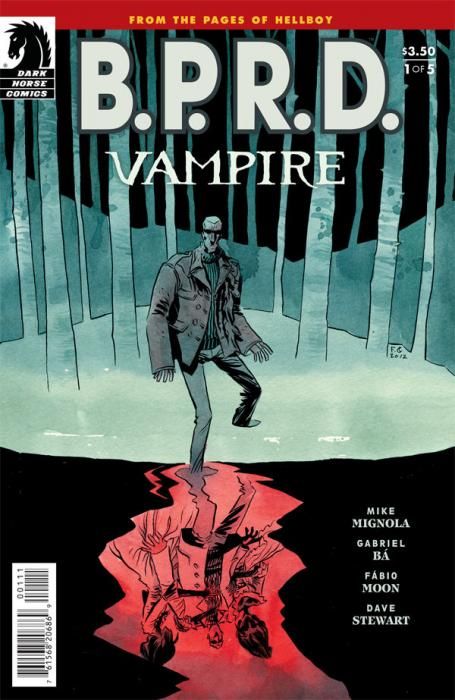Vampires are the stuff of nightmares, both literally and figuratively. Following directly after the events of "B.P.R.D.: 1948," "B.P.R.D.: Vampire" sees Bureau for Paranormal Research and Defense agent Simon Anders haunted by dreams of his last encounter with the creatures of the night. Anders's solution? Hunt them down and kill them all.
Mike Mignola, Gabriel Ba and Fabio Moon are all listed as writers on "Vampire," and the art is left up to the latter two. This is an indication of how much Mignola trusts Moon and Ba at this point, considering that the vast majority of Hellboy and B.P.R.D. comics have been written and drawn by Mignola solo. Fortunately, this trust is well placed. Moon and Ba leave behind the fatalistic humor that characterizes Mignola's Hellboy writing, and what's left is a comic that turns stark focus on the warped-mirror terror at the heart of the vampire myth. Vampires are fundamentally frightening because they're so nearly human -- a vampire can often pass for human until it turns into a bat or the fangs come out -- and yet somehow completely alien. The mindset of a vampire is characterized by a total lack of compassion and emotion, except for the famous overpowering bloodlust; this is a reflection of the worst aspects of human nature, taken to such an extreme as to become monstrous. Ba and Moon get that: the opening scene shows a vampire chewing on the gory heart of her victim, as the blood of those she's killed transform her from a grotesque, wretched monstrosity into a beautiful young woman. That the scene is written with five full pages of total silence -- no dialogue, no sound effects, just art -- only accentuates the loneliness and alienation of the vampiric mind.
Silence and loneliness are everywhere in "Vampire," not just reserved for the villains. Anders, our hero, also feels his humanity slipping away as he fights an overpowering anger that he fears he'll take out on his friends. His part of the story features plenty of silence as well, as he travels an empty train from station to empty station. The parallels between heroes and villains are stark, and it's B.P.R.D. founder Trevor Bruttenholm who casts the biggest, blackest shadow as he and Anders discuss the agent's nightmares. At the same time, Moon and Ba keep the vampires just different enough that readers know where the evil truly is. Anders dresses in sensible, drab clothes and wears his hair buzzed military short. The vampires dress like displaced French nobility, with huge bouffant hairdos and blood-drenched ballgowns. For vampires, beauty is a weapon, a tool to trick and seduce humanity until it's too late; Anders recognizes this false facade and implicitly rejects it.
Throughout, the art of "Vampire" is appropriately bleak. Dave Stewart's fabulous colors consist mostly of muted earth tones, and the few blues, whites and reds that do show up are seen as though through a dirty brown lens. There are no pure, strong colors here, except in a single flashback frame that shows a young Hellboy in his characteristic bright red. Over everything there is a huge amount of black ink: shadows, trees, skies, even water are all solid black. This is a world where horrible things lurk in impossibly dark shadows, a world of ambiguity where men feel themselves becoming monsters and monsters wear a human face.
There isn't really any action in "B.P.R.D.: Vampire" #1, as the issue just sets the scene for things to come, so readers looking for fantastical fight scenes will be disappointed. But Moon and Ba create an appealingly sinister, nuanced mood that begins to blur the lines between man and monster. I suspect this theme will only grow across the rest of the series, and I'm looking forward to seeing that happen.

